It’s the one big thing caravan owners dread – the smell and sight of damp!
The colder and wetter winter months when your caravan might have been left standing for a while can be an opportunity for the dreaded damp to grow and spread. Or, water ingress, after a spot of accidental damage to your caravan’s bodywork. It might be something as simple as a screw-hole that hasn’t been fully sealed, or some DIY work that hasn’t been properly sealed and finished.
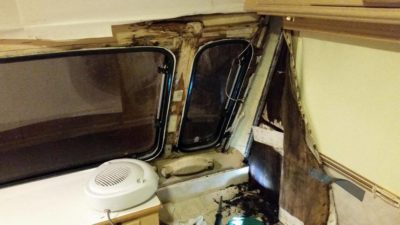
Faulty seals around windows, doors and rooflights are other areas where water can seep in. And, awning rails can be at the centre of a damp problem.
Damp can build up over time in a caravan and can also be caused by a build-up of condensation from equipment and people. Left alone, water ingress and damp, can quickly cause quite a bit of damage to your caravan. But act quickly and the problem can be easily sorted. An annual caravan service should always include a check for damp or water ingress, as well as checking for damp in your caravan yourself.
In this video, we will share some tips on preventing damp in your caravan:
Preventing damp in caravan
Prevention is always better than cure so here are our tips on preventing damp in your caravan.
Curb condensation and let the airflow
- Ventilation is key and one of the best ways to avoid damp is by using your caravan or motorhome as often as you can throughout the year. Failing that, on a monthly basis fling open the doors and windows for an hour or so, to let some fresh air in. Never be tempted to block any air vents, these are there for a reason, such as if there’s a gas leak.
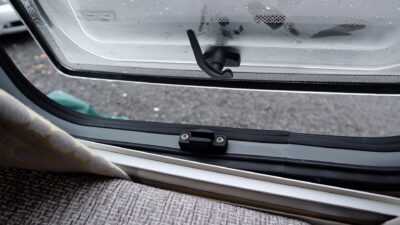
- Sleeping: If you find a build-up of condensation on windows and walls, particularly in areas close to people sleeping, then open the windows and give them a good wipe down with a clean microfibre cloth.
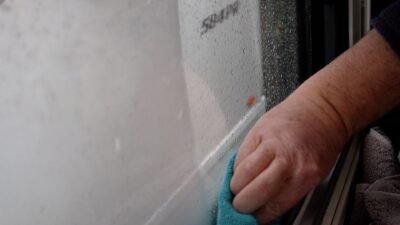
- Winter caravanning: Condensation is not uncommon when caravanning in the winter months, especially when the caravan is warmed up for the first time. In those instances wipe down the back of cupboards, ceilings, and walls where condensation has built up. In all cases, improving air circulation and maintaining a steady level of heating will reduce the condensation build-up.
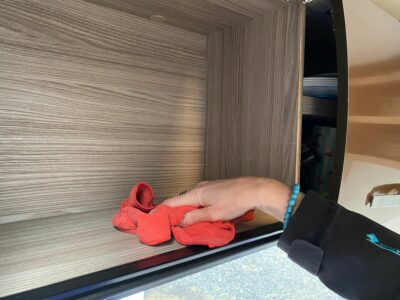
- Cooking: If you enjoy cooking in your caravan, keep a window or skylight slightly open to remove any steam buildup, and if possible, use lids on saucepans to limit the amount of steam. Once cooking and washing up has been completed, wipe down any walls, surfaces, and cupboards where moisture might still linger.
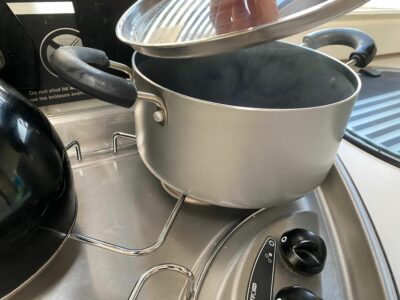
- Wet clothes and pets: Avoid bringing wet items into your caravan. Wet coats, swimsuits, and any damp clothing should be stored in the awning (if you have one) or make use of any laundry facilities on the campsite. Dry down any wet dogs before they enter the caravan using a large towel, this will also reduce the mud factor too!
- Washrooms: The most amount of moisture comes from your caravan’s washroom. When showering, keep the washroom window and skylight slightly open, and the door closed to avoid steam getting into the rest of the caravan or motorhome. Wipe the walls down when you’re done. If you can, air and dry damp towels outside, before returning to the washroom, or hang close to heating outlets.
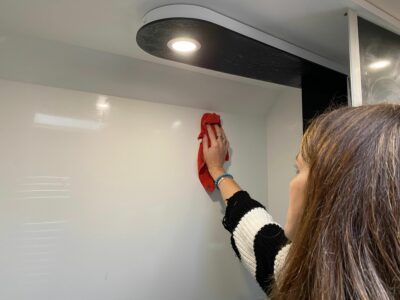
- Storage: When storing your caravan for long periods, particularly in the colder months, open all cupboard doors and remove bedding, towels, cushions, clothing, and even mattresses.
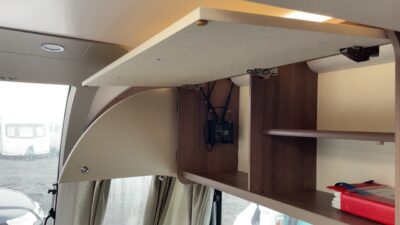
- Use moisture traps to reduce the effect of damp in areas with minimal air circulation.
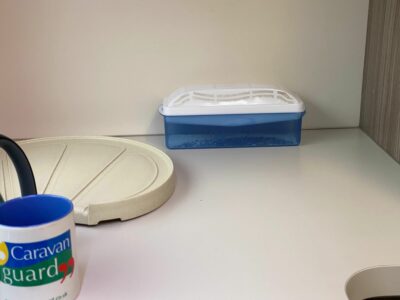
- Pull furniture away from the sides of the caravan, again to promote air movement, and if possible remove cushions to store in a dry place if you’re not going to be using your caravan in the winter months.
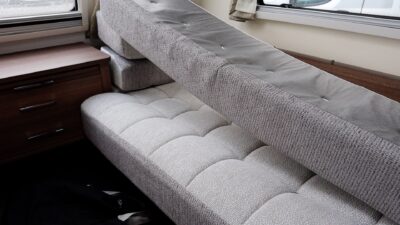
- Caravan cover: A waterproof but breathable cover when in storage will help prevent water ingress along with regular checks and door-opening visits. When checking up on your caravan in storage, turn on the heating for a short time with the windows open. This will let the air move around inside the caravan.
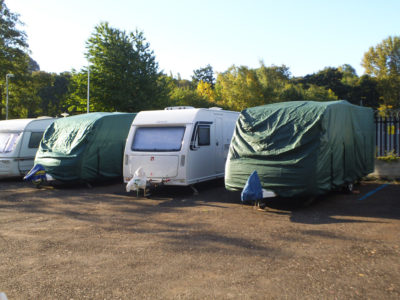
Checks for leaks
- As well as an annual habitation check or service, you should always be checking for any signs of water ingress or damage to seals.
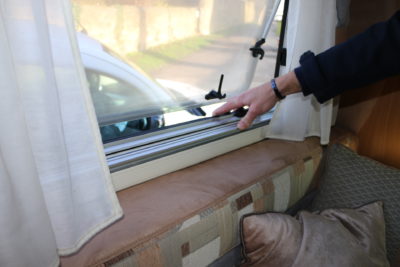
- Check seals around windows, doors and rooflights regularly, as well as where the caravan roof meets the side panels, by awning rails, and around any fitting on the outside of your caravan, such as a TV aerial or solar panel. It’s also worth paying close attention to heater or fridge flues.
- Cleaning: Keeping the caravan clean inside will help to keep damp to a minimum and might also detect early signs of trouble!
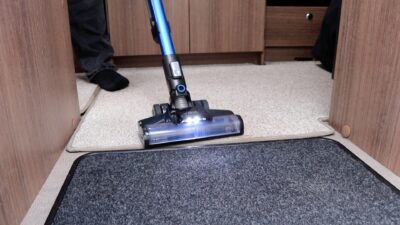
- Mop or wipe up any spills quickly and don’t store damp objects in lockers or wardrobes. When cleaning the outside of your caravan don’t use a power wash as this can damage seals and cause water ingress. And if you do spot a leak after washing the caravan or a heavy downpour, don’t ignore it. A quick repair could save you lots of expense in the longer term.
- Be constantly on the lookout for any signs of damp, particularly at the end of the season. Make sure you check under the beds, the backs of cupboards and lockers, and even under the beds.
Recognising damp in a caravan
- Use your nose! A musty, foisty smell is usually the first sign of damp
- Check for signs of black residue around windows, doors, and rooflights, as well as blue or pinkish staining to the wallboards. Soft walls can also point to serious damp trouble underneath
- If you’re buying a second-hand caravan, look out for any unusual-looking alterations, such as different interior wallboarding, as it can point to a past damp issue
- A creaky floor, or a spongey feel underfoot, is often a sign of delamination – again, where water or damp has got in. It can be very expensive to repair if you don’t catch it in time
- A damp meter is always a good investment and can give you an early heads-up before the problem spreads
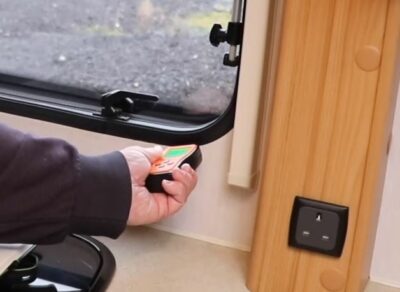
Treating damp and mould in caravan
- Remove patches of mould and mildew with a mould removal spray. Once dried use a mixture of clove oil and water and spray the area, leaving it for 20 minutes before wiping dry.
- If you can’t treat mould yourself or it has spread too far then it’s best to call for some expert help.
- Once any timber framework is affected by damp it can be tricky to sort out. Ideally, the wood needs to be thoroughly dried out and then the bodywork re-sealed. It can take time and you need to make sure you thoroughly dry out your caravan using heaters and/or dehumidifiers. It’s probably the time to call in the professionals too. An approved repairer or workshop will be able to carry out a full inspection and will be well-equipped to tackle the problem.
Will my caravan insurance pick up the bill to repair damp?
We’re unable to provide cover for damage caused by damp or rot issues, which is why it’s important to regularly check your caravan for any leaks or water ingress, particularly around seals, seams, windows, doors and skylights.
Over to you
Do you have any hints and tips on preventing or treating damp in a caravan? Please share any advice or experiences of dealing with damp below.


I’ve got a Swift 2 berth freestyle, 14 years old, and stored in the drive, no cover, I bought a 500W oil heater and its set on about the lowest setting, which is left on over winter, never had a problem with damp, and on the annual service the engineer always tells me its one of the driest vans he services, hope this helps someone else.
Damp found in our Swift when serviced in October. It’s still under warranty. Our dealer, who was quick to sell it to us, can’t even look at it until January. Great advice to sort it quick – if only it were possible.
Really useful advice but on a Bailey Alutech the main water ingress areas are from the roof strap, then the corners of the underfloor where the wall does not go below the floor lever sufficiently so the water can run onto the wooden floor soak it and delamination of the plywood.
As others have said, dehumidifiers or cat litter will draw damp out of the air that enters through vents etc, so completely useless in this scenario and in fact can contribute to damp problems due to the water collecting in them.
We have found a caravan, it’s our 1st to see if we like enjoy it, the man selling it said it has 30 percent damp on meter, it looks fine, no smells no mould or stains, patches on any cushions or in cupboards etc, we checked .. would you steer clear or still purchase , please advise. Thank you
It’s probably best to get a pre-purchase inspection from a specialist caravan engineer. There are mobile services such as Habcheck: https://habcheck.co.uk/page/caravan-pre-purchase-inspection or the MCEA: https://www.mobilecaravanengineers.co.uk/
All above is good sound advice but back to basics, even if you use your caravan or motorhome during autumn/winter months make sure you drain the water closet tank & casset. The condensation that forms on a full or half full tank walls can be quite spectacular, the rest is then up to gravity.
In reply to “Dave says:
29/01/2017 at 10:49 am ” – If this is a new van, then IMHO this may be worrying – but don’t panic (and spoil your pleasure of the caravan!). Go to the retailer and have it checked out asap. If not satisfied then the CC do have independent caravan engineers (CC members get a discounted price – see CC website). Good luck.
Thankyou for the practical tips I normally use damp crystals but I am going to give cat litter a go.we don’t suffer from damp but it’s good to take precautions especially now we get more rain and wind all year round.
Thanks for all your feedback there were lots of useful tips
Happy caravaning
Dave
Good article; plenty of good tips, thanks. There is one option left out – an electric dehumidifier. For those of us with caravans on the drive, or otherwise within reach of power, this has to be a great investment. A small one which can cope easily with a smallish van costs about £35 – the one which is Amazon’s Top Buy is brilliant. They switch themselves off when they have extracted enough water to fill the water tank.
My van is waterproof (single GRP moulding) so a dehumidifier runs for ages without filling up its water tank – it also warms the van slightly. People who have more of a damp problem may be happy to go out every two-three days to empty the water tank. Otherwise, you could get a larger machine (or two small ones), or use a small machine with a minor mod (easy to do on the model above-mentioned). By piping the extracted water not into the tank, but instead into your sink (with the machine standing on the draining board) it will never fill up, and so it will never switch itself off. For a few pence a day in running costs, it has to be worth it. It can be put on a timer plug to come on for just an hour or two a day.
Obviously, supervise closely at first to make sure there are no problems. Undoubtedly you have your caravan smoke alarms and they are linked to your house and smartphone so you know if they go off!!
I can leave all the upholstery, cushions and even bedding in place all winter ready for frequent getaways, and it’s always crisp and dry. I have airvents open for a small amount of airflow but still the air inside the caravan remains dry compared to moist air outside.
I find when I’m caravanning in the winter, there can be significant condensation resulting from coming into the van wearing damp clothes. I try to leave coats/boots in the car, but it can’t be avoided altogether. If I’m off-grid, I use an AlierKin Renewable Wireless Mini Dehumidifier – posh name for some crystals in a smart, slim plastic case which also contains a little heater. To discharge the water from the crystals after a few days, you plug it in (away from the caravan). Doubtless it works no better than a big bowl of crystals or cat-litter but it’s small and neat, can’t spill, and doesn’t raise questions from the neighbours about where the cat has gone!
Apart from an open bowl of crystals, as mentioned in the article, there are many types of closed ventilated pots which cannot spill, containing either cheap throwaway crystals, or more expensive recyclable ones which you dry out in an oven. People report mixed success in drying them out enough. Amazon has them all – search for dehumidifier or dehumidifier crystals – there are plenty of comments on which ones work best, many of them from caravanners.
Thanks Jenny – very comprehensive.
Have to admit, I don’t agree with the use of damp traps / moisture traps / kitty litter. Think about it, your caravan has multiple gas drop vents, under cooker, fridge, water heater, along with floor vents, wall vents, and rooflight vents. So the air within your caravan, with the slightest breeze is constantly changing.
So trying to capture any moisture from that air is a fruitless excercise as the air is constantly changing. So your moisture traps will capture as much as their capacity can, and then just sit there, wet. Not able to capture or absorb any more, and the air in your van will have changed again, due to the vents.
These moisture traps are surely only any use if you can 100% seal up any vents, and then and only would your damp tramps capture air within JUST the van, and not the rest of the world…..
Thanks for sharing your take on this David. You raise some good points.
I put 4 £1 dehumidifiers around the inside,and change them once &does the job caravan smells great as they are scented as well. Good advice with article thank you. Happy caravaning to all.
Thanks for the tip Robert
Good tips for new caravaners. Thank you.
Great advice. I have used the dehydration crystals but I am about to try the cat litter route.
Thanks Graham and good luck with the cat litter!
This is our 1st winter season so reading all the reviews we put down 5 bowls of salt in November
I went back to check last week to find 5 bowls of water but we did find some drips on the bathroom ceiling
This is a new van is this right
Great tips
Cheers
Thank you
My first year of having a caravan so will visit open all cupboards and put down tray cat litter thankyou for tip
Happy caravanning Sandra and thanks for the feedback 🙂
Leave the heating setting on low, just to keep it a nice warm temperature unit to keep the interior fine.
Thanks for the tip Robert.
This is what I do we have a protec cover over the van and when its frosty and foggy I put the ALDI heating on low I have been and checked van today and it is lovely inside I turned the heating off because it is mild here today
Thanks for the tip Alan.
I leave the heating on at minimum but cushions out and vents open, not had a problem with damp.
Still early days only been caravanning 42 years!
Great advice Richard 🙂
I’ve got an electric dehumidifier which I put in our motorhome at regular intervals, especially if we are going to use it after it’s stood through the winter.
Thanks Barbara.
Really useful practical advice, a timely reminder.
Good sound advice thank you.we have bought a low wattage tubular heater which just takes the initial chill off the van so hopefully with the crystals acting as a visual check we hope this will be an added deterrant By the way, am going to try cat litter as advised by a previous contributor because of its cheaper price and avoidance of emptying the crystal containers continually if needed.
Really good advice thank you
I regularly go to pound shop and purchase a couple of Crystal dehumidifier for a £1 and place two in the van for the winter. I usually collect approx 1/2 litre of weather over winter. Also stand cushions in van + open all cupboard doors. The main objective to allow air to circulate. Also don’t cover air vents under the beds.
Thankyou for all tips very useful. Our caravan is due in March.
Happy caravanning Stephen.
My husband and I have been caravanning for 30+ years and have never had a damp problem with any of our ‘vans. We always leave a large tray of cat litter in the ‘van when not in use, which is far cheaper than damp crystals and if your ‘van is a distance away from home there is no need to go to empty the water chamber!
Thanks Margaret. Cat litter seems to be a winner!
Great practical advice
I have used Prodripoles instead of messy crystals for a number of years and have found them easy to install and handle.A little expensive though.
Brilliant tips that everyone can and should take on board
Would it be a good idea if keep caravan at home to keep the heat on low in the winter months
I found this article very. Helpful and down to earth, good advice given in a easy to follow way,
Thanks Andrew.
Keep up the good work in tackling these common problems instead of just focusing on marketing for the caravan industry. They don’t buy yourcaravan insurance, we do